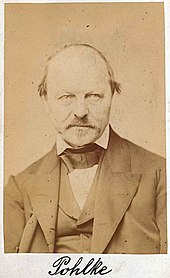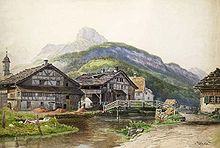Karl Wilhelm Pohlke
Karl Wilhelm Pohlke (born January 28, 1810 in Berlin ; † November 27, 1876 there ) was a German history , genre , portrait and landscape painter who found the " Sentence of Pohlke " named after him for perspective painting .
Life
Karl Wilhelm Pohlke received his painter training from Wilhelm Hensel at the Royal Prussian Academy of the Arts in Berlin and made his debut at the art exhibition there in 1832. After completing his studies, he earned his living for a few years with landscape painting and gave private lessons in the technique of perspective drawing. In 1835 Pohlke went to France, where he trained at the Paris École des Beaux-Arts with Louis Étienne Watelet and Léon Cogniet and in 1843 to Italy. After a 10-year absence, he moved back to Berlin in 1845. There he got a position as a private lecturer at the Royal Building Academy in 1849 and in 1860 became professor for descriptive geometry and perspective at the building and at the same time at the art academy.
Between 1860 and 1876 he published a textbook in two volumes on descriptive geometry, which deals with the "Pohlke Theorem", or "Main Theorem of Axonometry ", named after him in the first volume:
"Every flat, genuinely two-dimensional 'tripod' OABC can be obtained as a parallel projection of a three-dimensional Cartesian tripod O'A'B'C '."
With this sentence , which he had struggled to prove in vain since 1853, he was the first to find a mathematical formulation and thus a theoretical justification for the method of representation used in painting practice since the Renaissance for architectural views or perspective freehand drawings. "The sentence itself is one of the artist's most remarkable contributions to mathematics."
Works (selection)
Fonts
-
Descriptive geometry, initially for use in lectures at the Royal Building Academy and the Royal Commercial Institute in Berlin. Gaertner, Berlin 1860.
- First section: Representation of straight lines and flat surfaces, as well as the structures composed of them, by means of the different types of projection
- Second section: Representation of some crooked lines and curved surfaces.
- Ten tables for descriptive geometry . 4th edition. 1st – 2nd Division. Rudolph Gaertner, Berlin 1876 ( babel.hathitrust.org - alternative title: Descriptive Geometry ).
painting
- Fountain on Lake Lucerne , mid-19th century
- View of Glienicke , in Glienicke Palace , Berlin
literature
- Pohlke, Karl Wilhelm . In: Hans Vollmer (Hrsg.): General lexicon of fine artists from antiquity to the present . Founded by Ulrich Thieme and Felix Becker . tape 27 : Piermaria – Ramsdell . EA Seemann, Leipzig 1933, p. 192 .
- Frauke Josenhans: Pohlke, Carl Wilhelm. In: Bénédicte Savoy, France Nerlich (ed.): Paris apprenticeship years. A lexicon for training German painters in the French capital. Volume 1: 1793-1843. de Gruyter, Berlin / Boston 2013, pp. 228–230.
Web links
- Literature by and about Pohlke, Karl Wilhelm in the bibliographic database WorldCat
- Institute for Mathematics and Computer Science at the University of Greifswald: Mathematics and Art . Here: Karl Wilhelm Pohlke
- Karl Wilhelm Pohlke Catalogus Professorum - TU Berlin
Individual evidence
- ^ Theorem by Pohlke. In: Mathematics and Art. uni-reifswald.de, accessed on January 22, 2020 .
- ^ Karl Wilhelm Pohlke. In: Mathematics and Art. uni-reifswald.de, accessed on January 22, 2020 .
| personal data | |
|---|---|
| SURNAME | Pohlke, Karl Wilhelm |
| ALTERNATIVE NAMES | Pohlke, Carl Wilhelm (different spelling); Pohlke, Karl |
| BRIEF DESCRIPTION | German history, genre, portrait and landscape painter |
| DATE OF BIRTH | January 28, 1810 |
| PLACE OF BIRTH | Berlin |
| DATE OF DEATH | November 27, 1876 |
| Place of death | Berlin |

